Business Analysis Techniques: Synopsis, Reflection, and Critique
VerifiedAdded on 2022/09/30
|12
|3187
|23
Report
AI Summary
This assignment provides a critical review of various business analysis techniques. It covers core competencies based on the Business Analysis Body of Knowledge (BABOK), emphasizing the importance of problem-solving, communication, and software skills for business analysts. The review also highlights the critical skills needed for designing and developing new technologies, including leadership and team-building abilities. Furthermore, it discusses models for strategy formulation, analyzing both the external and internal environments of an organization, and the relationship between organizational strategy and a knowledge audit plan. The assignment also addresses the leadership and team-building skills required by a business analyst, as well as key processes involved in understanding the business context, such as observation, interviews, and open discussion sessions. The student also reflects on the importance of creative leadership and innovation to improve business.
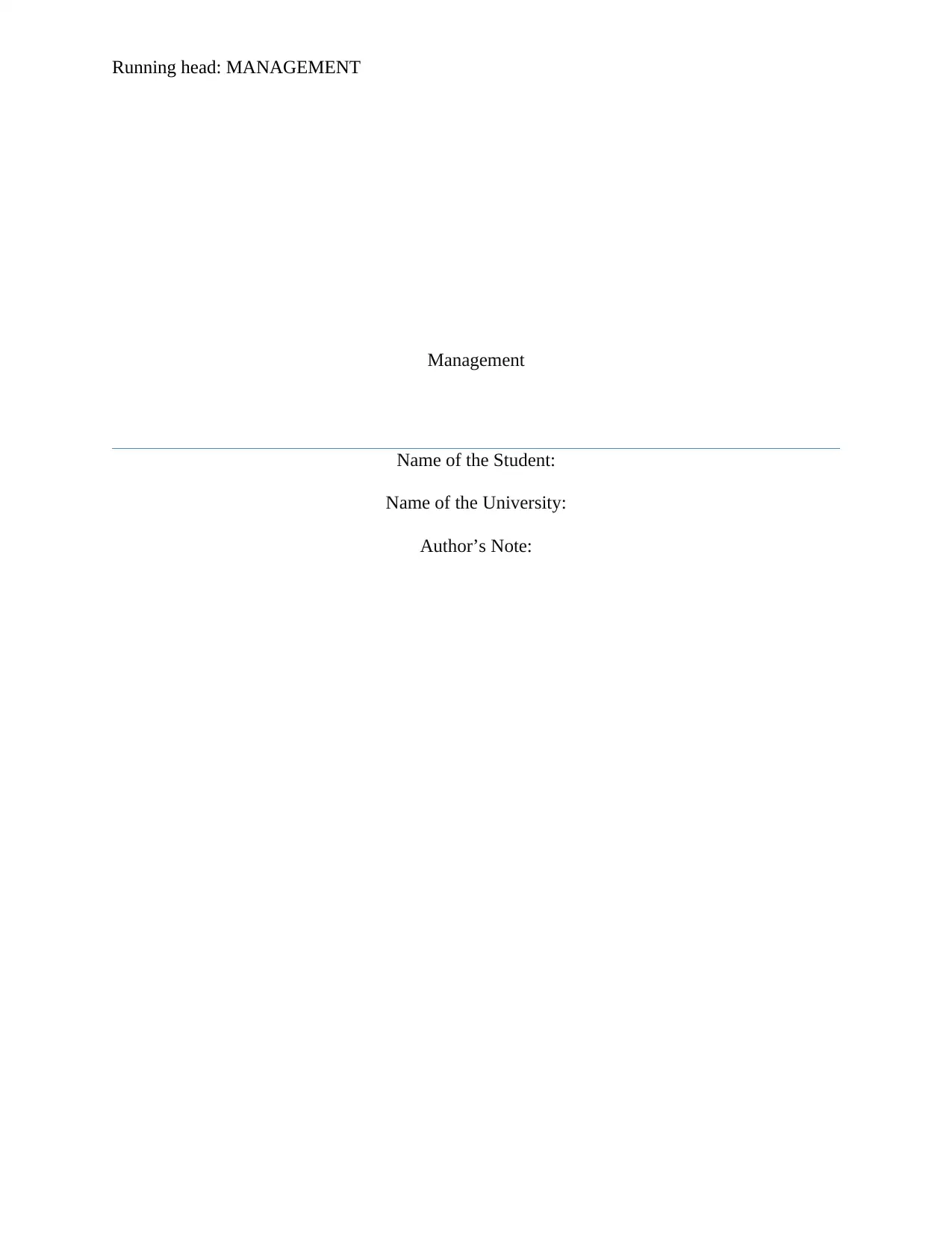
Running head: MANAGEMENT
Management
Name of the Student:
Name of the University:
Author’s Note:
Management
Name of the Student:
Name of the University:
Author’s Note:
Paraphrase This Document
Need a fresh take? Get an instant paraphrase of this document with our AI Paraphraser
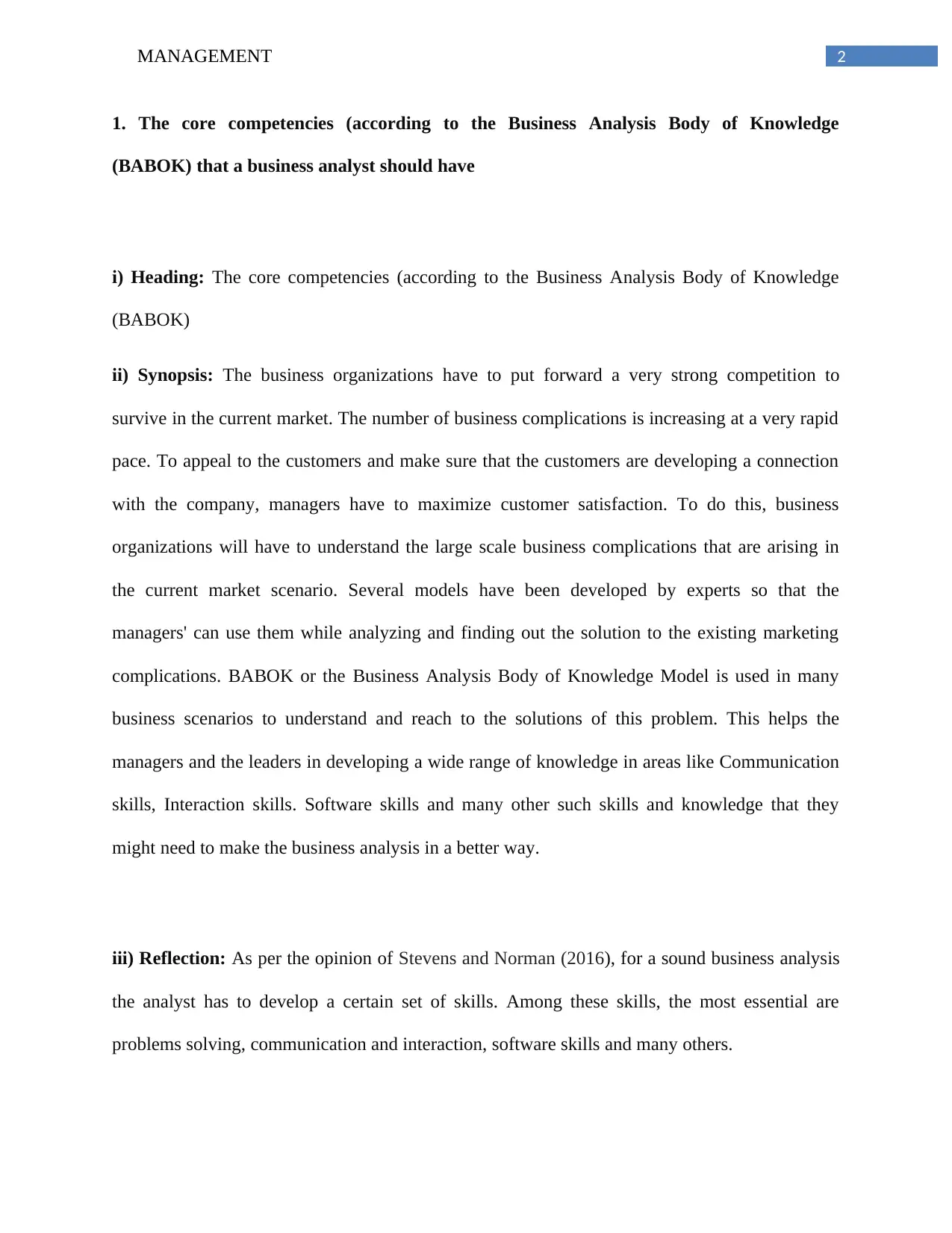
2MANAGEMENT
1. The core competencies (according to the Business Analysis Body of Knowledge
(BABOK) that a business analyst should have
i) Heading: The core competencies (according to the Business Analysis Body of Knowledge
(BABOK)
ii) Synopsis: The business organizations have to put forward a very strong competition to
survive in the current market. The number of business complications is increasing at a very rapid
pace. To appeal to the customers and make sure that the customers are developing a connection
with the company, managers have to maximize customer satisfaction. To do this, business
organizations will have to understand the large scale business complications that are arising in
the current market scenario. Several models have been developed by experts so that the
managers' can use them while analyzing and finding out the solution to the existing marketing
complications. BABOK or the Business Analysis Body of Knowledge Model is used in many
business scenarios to understand and reach to the solutions of this problem. This helps the
managers and the leaders in developing a wide range of knowledge in areas like Communication
skills, Interaction skills. Software skills and many other such skills and knowledge that they
might need to make the business analysis in a better way.
iii) Reflection: As per the opinion of Stevens and Norman (2016), for a sound business analysis
the analyst has to develop a certain set of skills. Among these skills, the most essential are
problems solving, communication and interaction, software skills and many others.
1. The core competencies (according to the Business Analysis Body of Knowledge
(BABOK) that a business analyst should have
i) Heading: The core competencies (according to the Business Analysis Body of Knowledge
(BABOK)
ii) Synopsis: The business organizations have to put forward a very strong competition to
survive in the current market. The number of business complications is increasing at a very rapid
pace. To appeal to the customers and make sure that the customers are developing a connection
with the company, managers have to maximize customer satisfaction. To do this, business
organizations will have to understand the large scale business complications that are arising in
the current market scenario. Several models have been developed by experts so that the
managers' can use them while analyzing and finding out the solution to the existing marketing
complications. BABOK or the Business Analysis Body of Knowledge Model is used in many
business scenarios to understand and reach to the solutions of this problem. This helps the
managers and the leaders in developing a wide range of knowledge in areas like Communication
skills, Interaction skills. Software skills and many other such skills and knowledge that they
might need to make the business analysis in a better way.
iii) Reflection: As per the opinion of Stevens and Norman (2016), for a sound business analysis
the analyst has to develop a certain set of skills. Among these skills, the most essential are
problems solving, communication and interaction, software skills and many others.
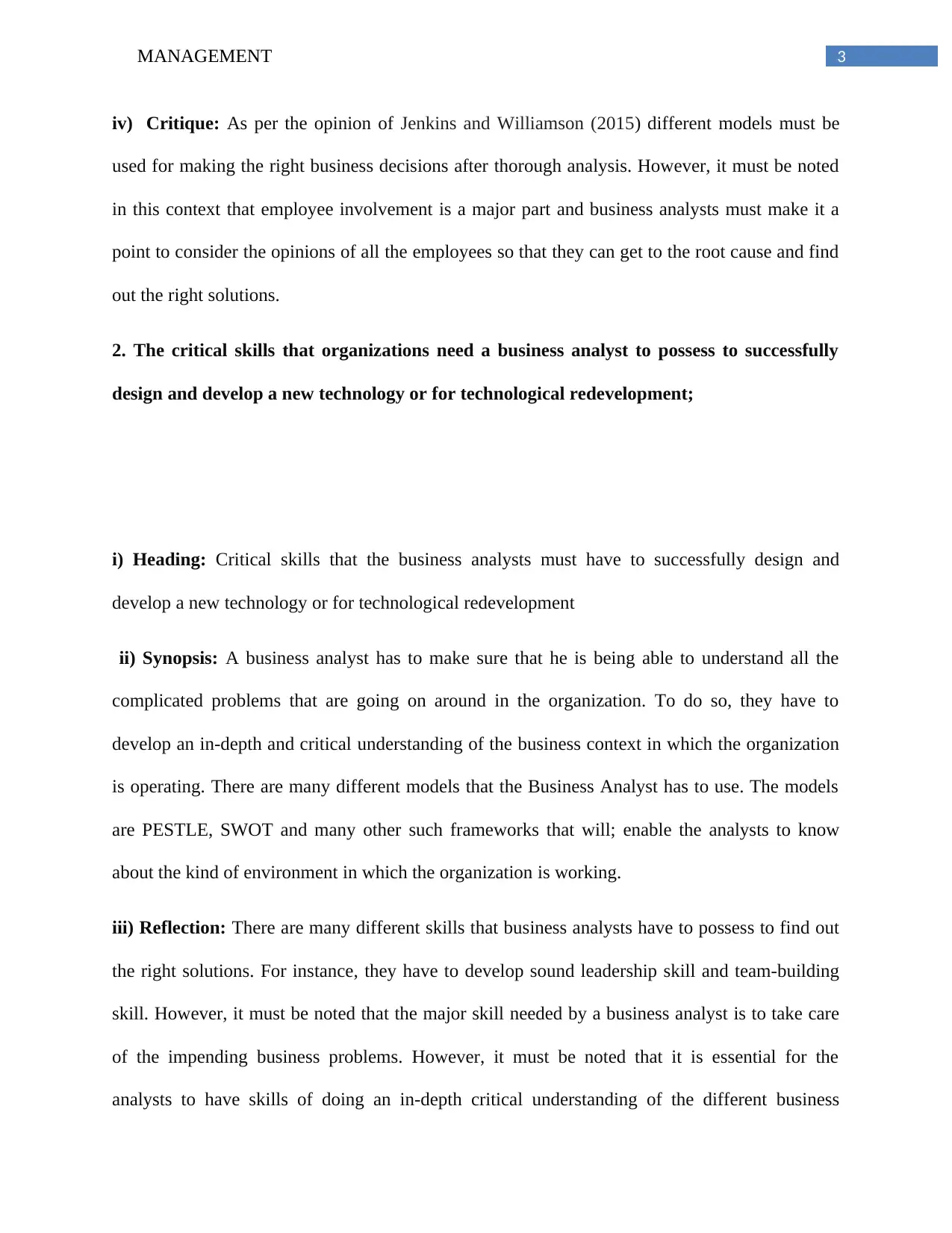
3MANAGEMENT
iv) Critique: As per the opinion of Jenkins and Williamson (2015) different models must be
used for making the right business decisions after thorough analysis. However, it must be noted
in this context that employee involvement is a major part and business analysts must make it a
point to consider the opinions of all the employees so that they can get to the root cause and find
out the right solutions.
2. The critical skills that organizations need a business analyst to possess to successfully
design and develop a new technology or for technological redevelopment;
i) Heading: Critical skills that the business analysts must have to successfully design and
develop a new technology or for technological redevelopment
ii) Synopsis: A business analyst has to make sure that he is being able to understand all the
complicated problems that are going on around in the organization. To do so, they have to
develop an in-depth and critical understanding of the business context in which the organization
is operating. There are many different models that the Business Analyst has to use. The models
are PESTLE, SWOT and many other such frameworks that will; enable the analysts to know
about the kind of environment in which the organization is working.
iii) Reflection: There are many different skills that business analysts have to possess to find out
the right solutions. For instance, they have to develop sound leadership skill and team-building
skill. However, it must be noted that the major skill needed by a business analyst is to take care
of the impending business problems. However, it must be noted that it is essential for the
analysts to have skills of doing an in-depth critical understanding of the different business
iv) Critique: As per the opinion of Jenkins and Williamson (2015) different models must be
used for making the right business decisions after thorough analysis. However, it must be noted
in this context that employee involvement is a major part and business analysts must make it a
point to consider the opinions of all the employees so that they can get to the root cause and find
out the right solutions.
2. The critical skills that organizations need a business analyst to possess to successfully
design and develop a new technology or for technological redevelopment;
i) Heading: Critical skills that the business analysts must have to successfully design and
develop a new technology or for technological redevelopment
ii) Synopsis: A business analyst has to make sure that he is being able to understand all the
complicated problems that are going on around in the organization. To do so, they have to
develop an in-depth and critical understanding of the business context in which the organization
is operating. There are many different models that the Business Analyst has to use. The models
are PESTLE, SWOT and many other such frameworks that will; enable the analysts to know
about the kind of environment in which the organization is working.
iii) Reflection: There are many different skills that business analysts have to possess to find out
the right solutions. For instance, they have to develop sound leadership skill and team-building
skill. However, it must be noted that the major skill needed by a business analyst is to take care
of the impending business problems. However, it must be noted that it is essential for the
analysts to have skills of doing an in-depth critical understanding of the different business
⊘ This is a preview!⊘
Do you want full access?
Subscribe today to unlock all pages.

Trusted by 1+ million students worldwide
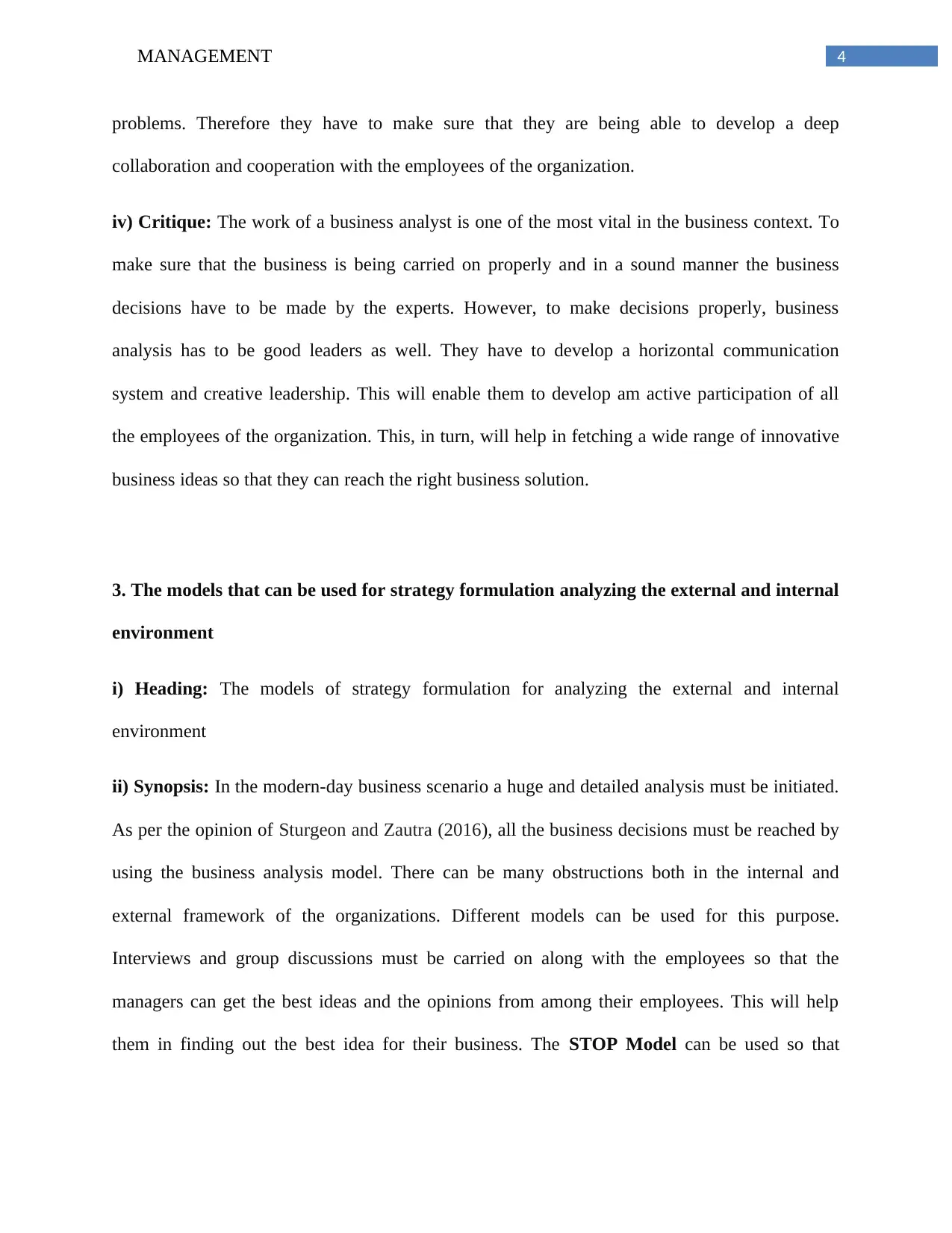
4MANAGEMENT
problems. Therefore they have to make sure that they are being able to develop a deep
collaboration and cooperation with the employees of the organization.
iv) Critique: The work of a business analyst is one of the most vital in the business context. To
make sure that the business is being carried on properly and in a sound manner the business
decisions have to be made by the experts. However, to make decisions properly, business
analysis has to be good leaders as well. They have to develop a horizontal communication
system and creative leadership. This will enable them to develop am active participation of all
the employees of the organization. This, in turn, will help in fetching a wide range of innovative
business ideas so that they can reach the right business solution.
3. The models that can be used for strategy formulation analyzing the external and internal
environment
i) Heading: The models of strategy formulation for analyzing the external and internal
environment
ii) Synopsis: In the modern-day business scenario a huge and detailed analysis must be initiated.
As per the opinion of Sturgeon and Zautra (2016), all the business decisions must be reached by
using the business analysis model. There can be many obstructions both in the internal and
external framework of the organizations. Different models can be used for this purpose.
Interviews and group discussions must be carried on along with the employees so that the
managers can get the best ideas and the opinions from among their employees. This will help
them in finding out the best idea for their business. The STOP Model can be used so that
problems. Therefore they have to make sure that they are being able to develop a deep
collaboration and cooperation with the employees of the organization.
iv) Critique: The work of a business analyst is one of the most vital in the business context. To
make sure that the business is being carried on properly and in a sound manner the business
decisions have to be made by the experts. However, to make decisions properly, business
analysis has to be good leaders as well. They have to develop a horizontal communication
system and creative leadership. This will enable them to develop am active participation of all
the employees of the organization. This, in turn, will help in fetching a wide range of innovative
business ideas so that they can reach the right business solution.
3. The models that can be used for strategy formulation analyzing the external and internal
environment
i) Heading: The models of strategy formulation for analyzing the external and internal
environment
ii) Synopsis: In the modern-day business scenario a huge and detailed analysis must be initiated.
As per the opinion of Sturgeon and Zautra (2016), all the business decisions must be reached by
using the business analysis model. There can be many obstructions both in the internal and
external framework of the organizations. Different models can be used for this purpose.
Interviews and group discussions must be carried on along with the employees so that the
managers can get the best ideas and the opinions from among their employees. This will help
them in finding out the best idea for their business. The STOP Model can be used so that
Paraphrase This Document
Need a fresh take? Get an instant paraphrase of this document with our AI Paraphraser
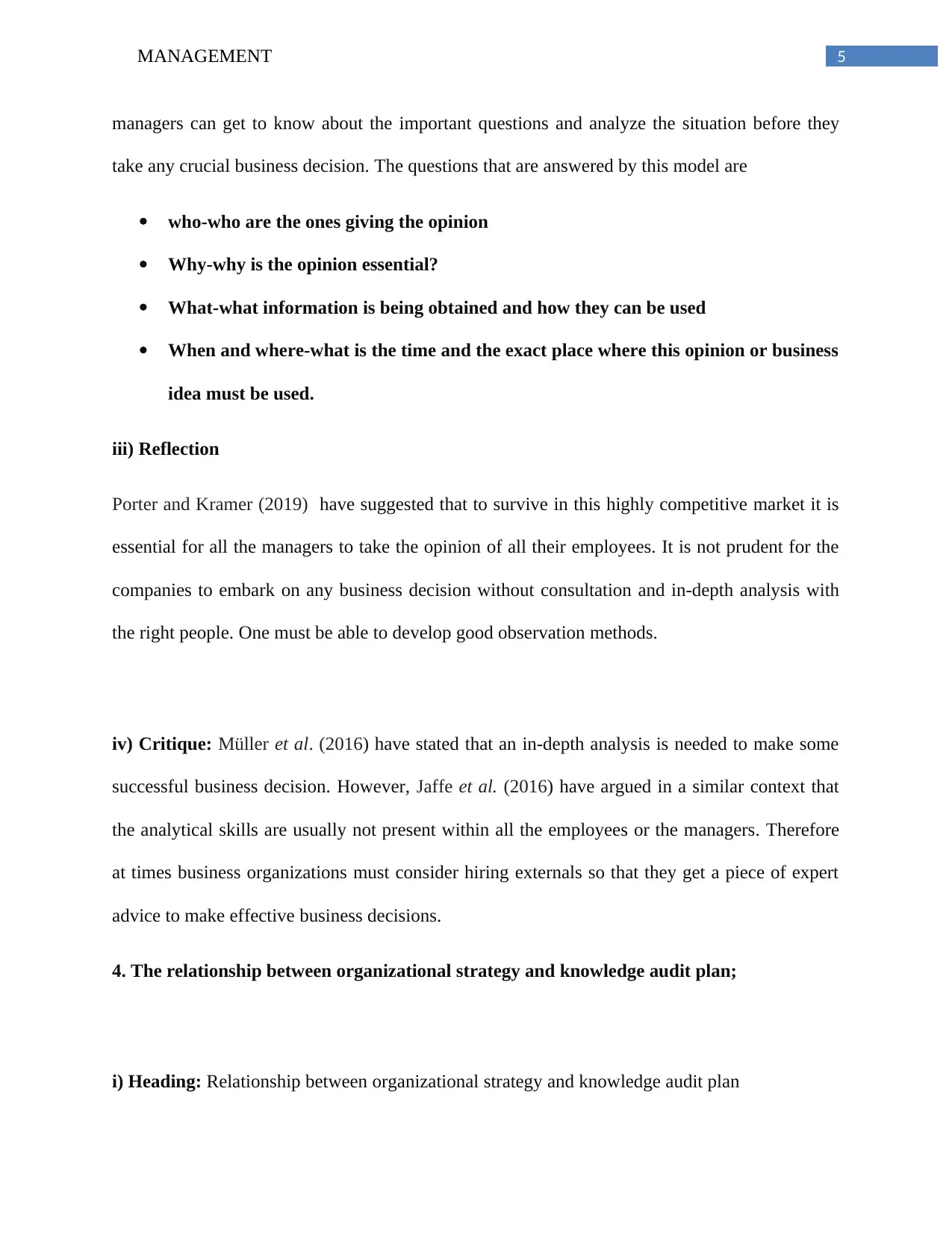
5MANAGEMENT
managers can get to know about the important questions and analyze the situation before they
take any crucial business decision. The questions that are answered by this model are
who-who are the ones giving the opinion
Why-why is the opinion essential?
What-what information is being obtained and how they can be used
When and where-what is the time and the exact place where this opinion or business
idea must be used.
iii) Reflection
Porter and Kramer (2019) have suggested that to survive in this highly competitive market it is
essential for all the managers to take the opinion of all their employees. It is not prudent for the
companies to embark on any business decision without consultation and in-depth analysis with
the right people. One must be able to develop good observation methods.
iv) Critique: Müller et al. (2016) have stated that an in-depth analysis is needed to make some
successful business decision. However, Jaffe et al. (2016) have argued in a similar context that
the analytical skills are usually not present within all the employees or the managers. Therefore
at times business organizations must consider hiring externals so that they get a piece of expert
advice to make effective business decisions.
4. The relationship between organizational strategy and knowledge audit plan;
i) Heading: Relationship between organizational strategy and knowledge audit plan
managers can get to know about the important questions and analyze the situation before they
take any crucial business decision. The questions that are answered by this model are
who-who are the ones giving the opinion
Why-why is the opinion essential?
What-what information is being obtained and how they can be used
When and where-what is the time and the exact place where this opinion or business
idea must be used.
iii) Reflection
Porter and Kramer (2019) have suggested that to survive in this highly competitive market it is
essential for all the managers to take the opinion of all their employees. It is not prudent for the
companies to embark on any business decision without consultation and in-depth analysis with
the right people. One must be able to develop good observation methods.
iv) Critique: Müller et al. (2016) have stated that an in-depth analysis is needed to make some
successful business decision. However, Jaffe et al. (2016) have argued in a similar context that
the analytical skills are usually not present within all the employees or the managers. Therefore
at times business organizations must consider hiring externals so that they get a piece of expert
advice to make effective business decisions.
4. The relationship between organizational strategy and knowledge audit plan;
i) Heading: Relationship between organizational strategy and knowledge audit plan
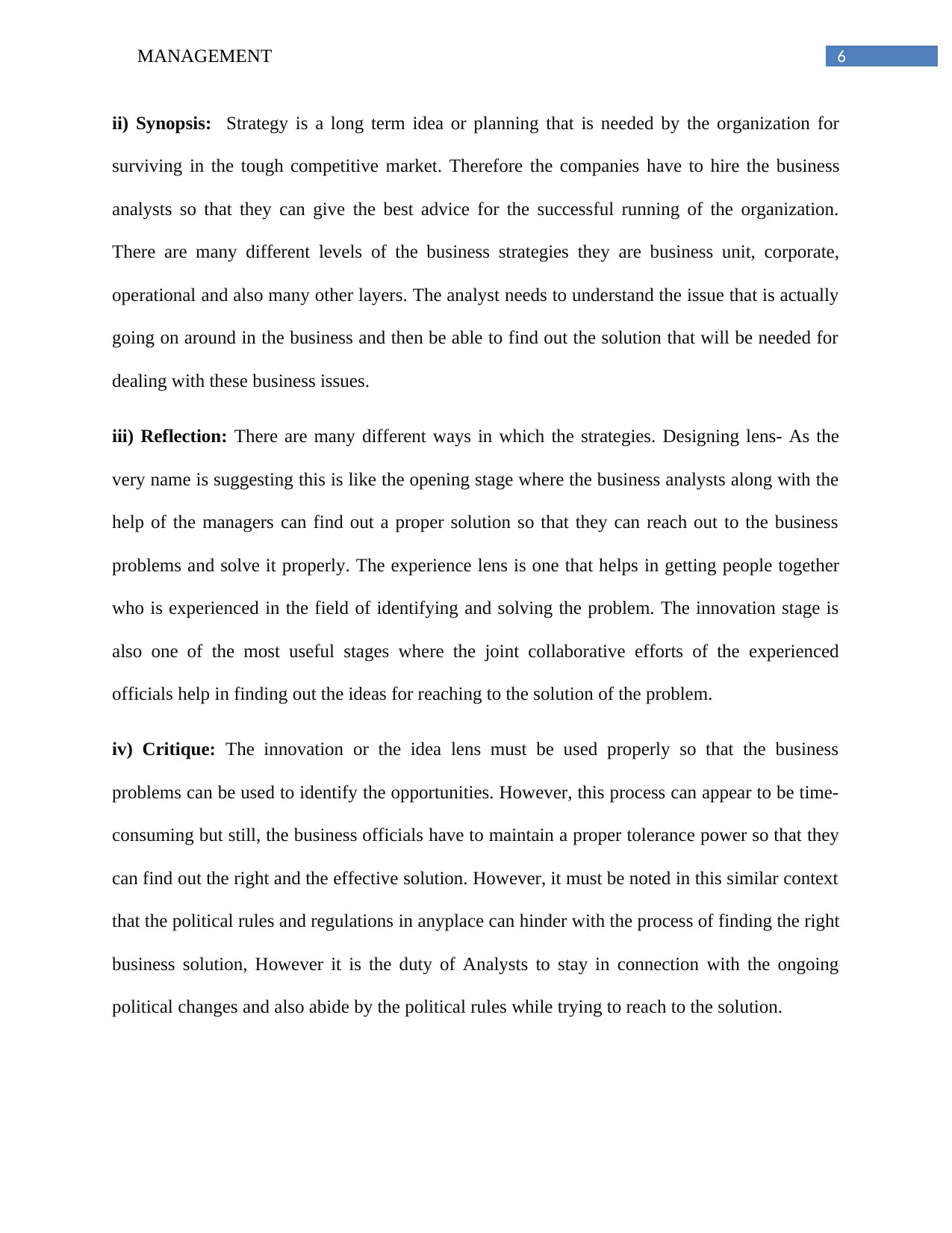
6MANAGEMENT
ii) Synopsis: Strategy is a long term idea or planning that is needed by the organization for
surviving in the tough competitive market. Therefore the companies have to hire the business
analysts so that they can give the best advice for the successful running of the organization.
There are many different levels of the business strategies they are business unit, corporate,
operational and also many other layers. The analyst needs to understand the issue that is actually
going on around in the business and then be able to find out the solution that will be needed for
dealing with these business issues.
iii) Reflection: There are many different ways in which the strategies. Designing lens- As the
very name is suggesting this is like the opening stage where the business analysts along with the
help of the managers can find out a proper solution so that they can reach out to the business
problems and solve it properly. The experience lens is one that helps in getting people together
who is experienced in the field of identifying and solving the problem. The innovation stage is
also one of the most useful stages where the joint collaborative efforts of the experienced
officials help in finding out the ideas for reaching to the solution of the problem.
iv) Critique: The innovation or the idea lens must be used properly so that the business
problems can be used to identify the opportunities. However, this process can appear to be time-
consuming but still, the business officials have to maintain a proper tolerance power so that they
can find out the right and the effective solution. However, it must be noted in this similar context
that the political rules and regulations in anyplace can hinder with the process of finding the right
business solution, However it is the duty of Analysts to stay in connection with the ongoing
political changes and also abide by the political rules while trying to reach to the solution.
ii) Synopsis: Strategy is a long term idea or planning that is needed by the organization for
surviving in the tough competitive market. Therefore the companies have to hire the business
analysts so that they can give the best advice for the successful running of the organization.
There are many different levels of the business strategies they are business unit, corporate,
operational and also many other layers. The analyst needs to understand the issue that is actually
going on around in the business and then be able to find out the solution that will be needed for
dealing with these business issues.
iii) Reflection: There are many different ways in which the strategies. Designing lens- As the
very name is suggesting this is like the opening stage where the business analysts along with the
help of the managers can find out a proper solution so that they can reach out to the business
problems and solve it properly. The experience lens is one that helps in getting people together
who is experienced in the field of identifying and solving the problem. The innovation stage is
also one of the most useful stages where the joint collaborative efforts of the experienced
officials help in finding out the ideas for reaching to the solution of the problem.
iv) Critique: The innovation or the idea lens must be used properly so that the business
problems can be used to identify the opportunities. However, this process can appear to be time-
consuming but still, the business officials have to maintain a proper tolerance power so that they
can find out the right and the effective solution. However, it must be noted in this similar context
that the political rules and regulations in anyplace can hinder with the process of finding the right
business solution, However it is the duty of Analysts to stay in connection with the ongoing
political changes and also abide by the political rules while trying to reach to the solution.
⊘ This is a preview!⊘
Do you want full access?
Subscribe today to unlock all pages.

Trusted by 1+ million students worldwide
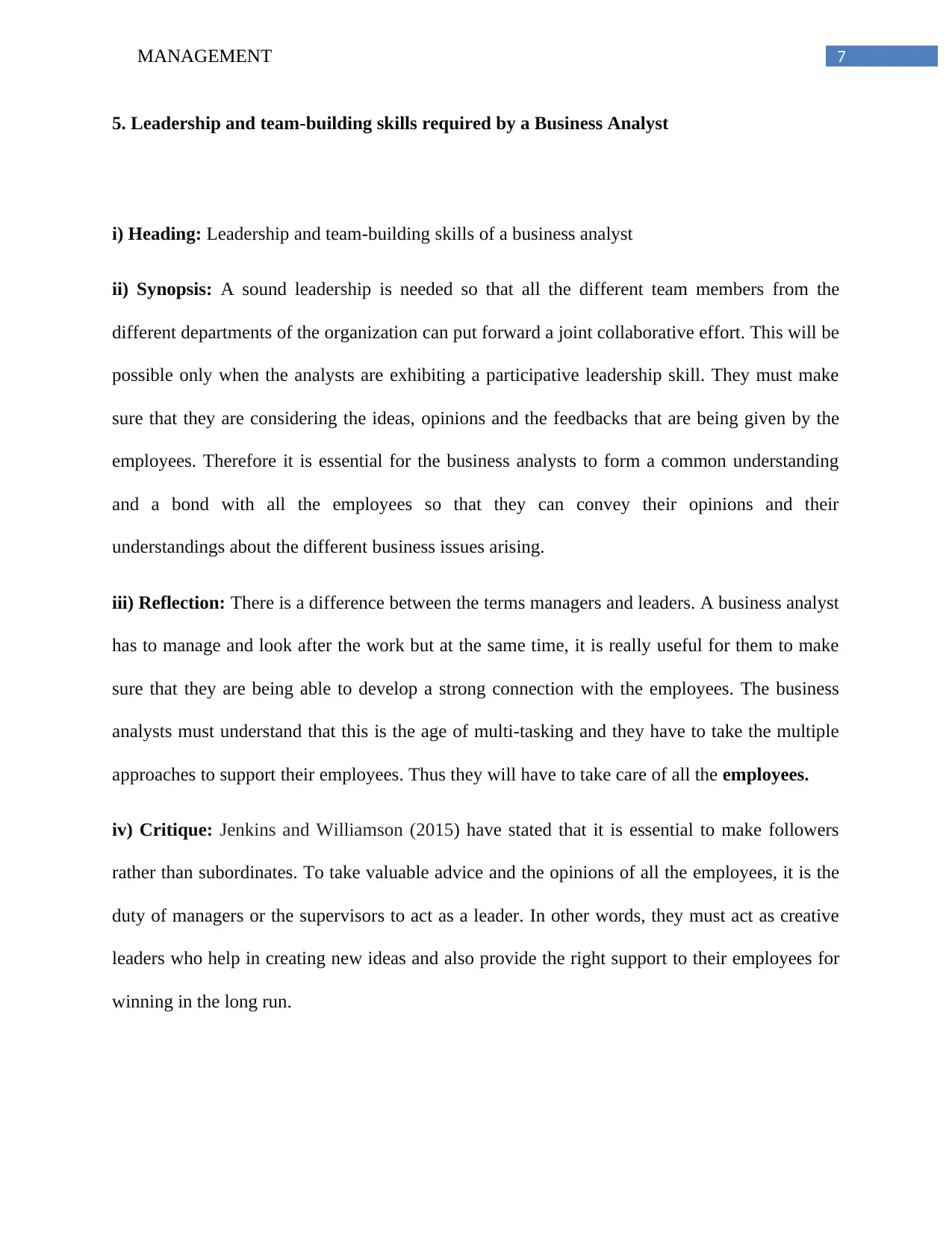
7MANAGEMENT
5. Leadership and team-building skills required by a Business Analyst
i) Heading: Leadership and team-building skills of a business analyst
ii) Synopsis: A sound leadership is needed so that all the different team members from the
different departments of the organization can put forward a joint collaborative effort. This will be
possible only when the analysts are exhibiting a participative leadership skill. They must make
sure that they are considering the ideas, opinions and the feedbacks that are being given by the
employees. Therefore it is essential for the business analysts to form a common understanding
and a bond with all the employees so that they can convey their opinions and their
understandings about the different business issues arising.
iii) Reflection: There is a difference between the terms managers and leaders. A business analyst
has to manage and look after the work but at the same time, it is really useful for them to make
sure that they are being able to develop a strong connection with the employees. The business
analysts must understand that this is the age of multi-tasking and they have to take the multiple
approaches to support their employees. Thus they will have to take care of all the employees.
iv) Critique: Jenkins and Williamson (2015) have stated that it is essential to make followers
rather than subordinates. To take valuable advice and the opinions of all the employees, it is the
duty of managers or the supervisors to act as a leader. In other words, they must act as creative
leaders who help in creating new ideas and also provide the right support to their employees for
winning in the long run.
5. Leadership and team-building skills required by a Business Analyst
i) Heading: Leadership and team-building skills of a business analyst
ii) Synopsis: A sound leadership is needed so that all the different team members from the
different departments of the organization can put forward a joint collaborative effort. This will be
possible only when the analysts are exhibiting a participative leadership skill. They must make
sure that they are considering the ideas, opinions and the feedbacks that are being given by the
employees. Therefore it is essential for the business analysts to form a common understanding
and a bond with all the employees so that they can convey their opinions and their
understandings about the different business issues arising.
iii) Reflection: There is a difference between the terms managers and leaders. A business analyst
has to manage and look after the work but at the same time, it is really useful for them to make
sure that they are being able to develop a strong connection with the employees. The business
analysts must understand that this is the age of multi-tasking and they have to take the multiple
approaches to support their employees. Thus they will have to take care of all the employees.
iv) Critique: Jenkins and Williamson (2015) have stated that it is essential to make followers
rather than subordinates. To take valuable advice and the opinions of all the employees, it is the
duty of managers or the supervisors to act as a leader. In other words, they must act as creative
leaders who help in creating new ideas and also provide the right support to their employees for
winning in the long run.
Paraphrase This Document
Need a fresh take? Get an instant paraphrase of this document with our AI Paraphraser
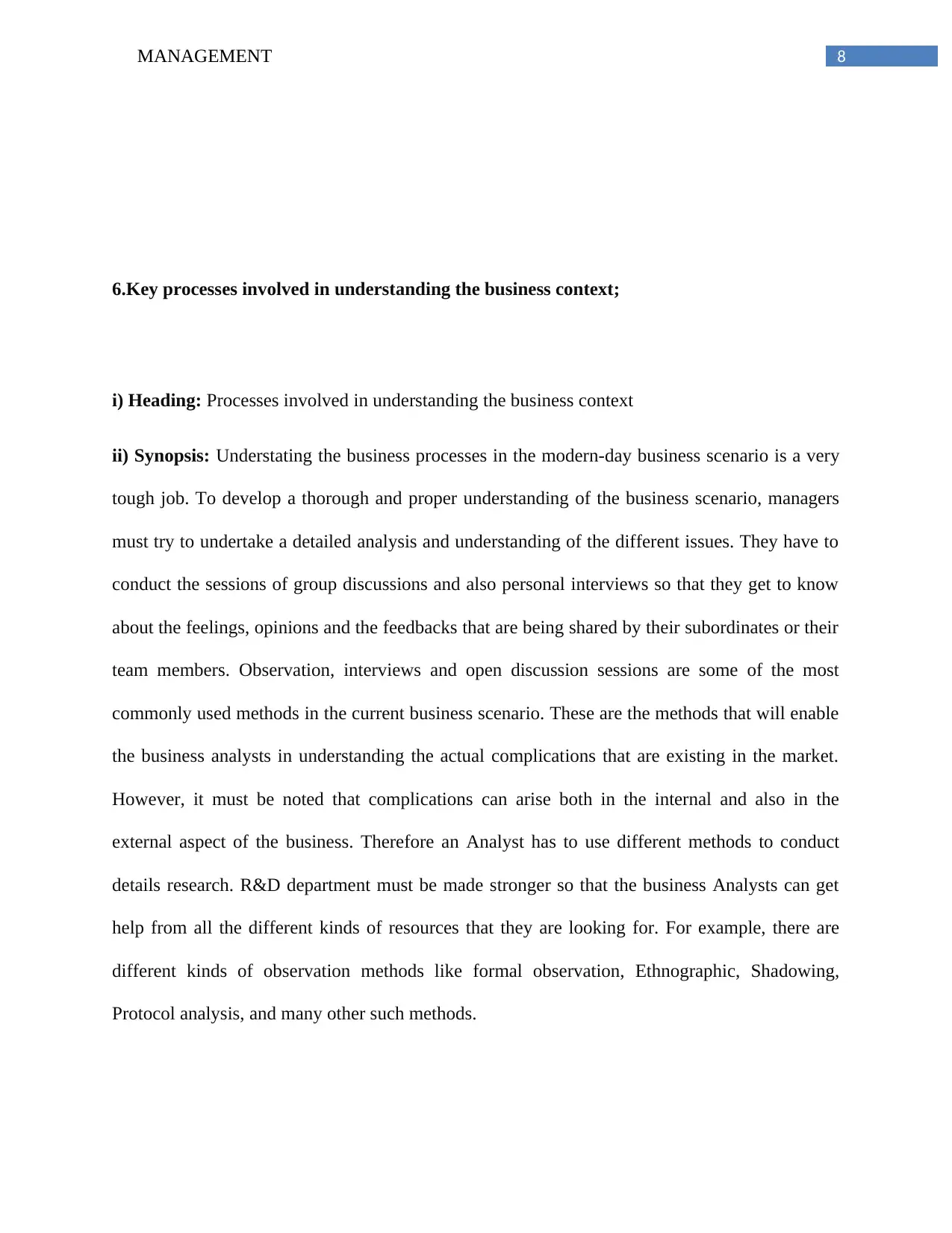
8MANAGEMENT
6.Key processes involved in understanding the business context;
i) Heading: Processes involved in understanding the business context
ii) Synopsis: Understating the business processes in the modern-day business scenario is a very
tough job. To develop a thorough and proper understanding of the business scenario, managers
must try to undertake a detailed analysis and understanding of the different issues. They have to
conduct the sessions of group discussions and also personal interviews so that they get to know
about the feelings, opinions and the feedbacks that are being shared by their subordinates or their
team members. Observation, interviews and open discussion sessions are some of the most
commonly used methods in the current business scenario. These are the methods that will enable
the business analysts in understanding the actual complications that are existing in the market.
However, it must be noted that complications can arise both in the internal and also in the
external aspect of the business. Therefore an Analyst has to use different methods to conduct
details research. R&D department must be made stronger so that the business Analysts can get
help from all the different kinds of resources that they are looking for. For example, there are
different kinds of observation methods like formal observation, Ethnographic, Shadowing,
Protocol analysis, and many other such methods.
6.Key processes involved in understanding the business context;
i) Heading: Processes involved in understanding the business context
ii) Synopsis: Understating the business processes in the modern-day business scenario is a very
tough job. To develop a thorough and proper understanding of the business scenario, managers
must try to undertake a detailed analysis and understanding of the different issues. They have to
conduct the sessions of group discussions and also personal interviews so that they get to know
about the feelings, opinions and the feedbacks that are being shared by their subordinates or their
team members. Observation, interviews and open discussion sessions are some of the most
commonly used methods in the current business scenario. These are the methods that will enable
the business analysts in understanding the actual complications that are existing in the market.
However, it must be noted that complications can arise both in the internal and also in the
external aspect of the business. Therefore an Analyst has to use different methods to conduct
details research. R&D department must be made stronger so that the business Analysts can get
help from all the different kinds of resources that they are looking for. For example, there are
different kinds of observation methods like formal observation, Ethnographic, Shadowing,
Protocol analysis, and many other such methods.
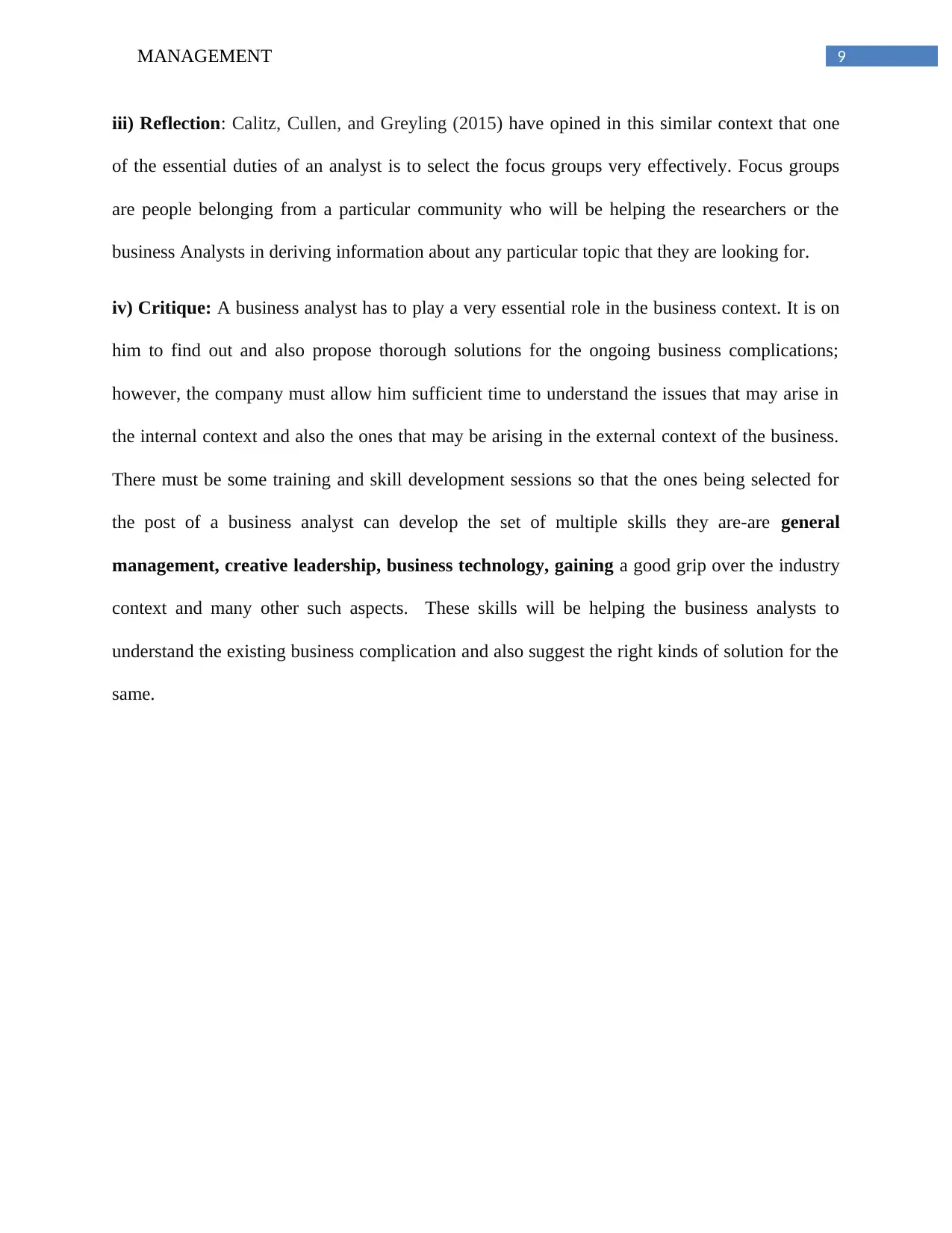
9MANAGEMENT
iii) Reflection: Calitz, Cullen, and Greyling (2015) have opined in this similar context that one
of the essential duties of an analyst is to select the focus groups very effectively. Focus groups
are people belonging from a particular community who will be helping the researchers or the
business Analysts in deriving information about any particular topic that they are looking for.
iv) Critique: A business analyst has to play a very essential role in the business context. It is on
him to find out and also propose thorough solutions for the ongoing business complications;
however, the company must allow him sufficient time to understand the issues that may arise in
the internal context and also the ones that may be arising in the external context of the business.
There must be some training and skill development sessions so that the ones being selected for
the post of a business analyst can develop the set of multiple skills they are-are general
management, creative leadership, business technology, gaining a good grip over the industry
context and many other such aspects. These skills will be helping the business analysts to
understand the existing business complication and also suggest the right kinds of solution for the
same.
iii) Reflection: Calitz, Cullen, and Greyling (2015) have opined in this similar context that one
of the essential duties of an analyst is to select the focus groups very effectively. Focus groups
are people belonging from a particular community who will be helping the researchers or the
business Analysts in deriving information about any particular topic that they are looking for.
iv) Critique: A business analyst has to play a very essential role in the business context. It is on
him to find out and also propose thorough solutions for the ongoing business complications;
however, the company must allow him sufficient time to understand the issues that may arise in
the internal context and also the ones that may be arising in the external context of the business.
There must be some training and skill development sessions so that the ones being selected for
the post of a business analyst can develop the set of multiple skills they are-are general
management, creative leadership, business technology, gaining a good grip over the industry
context and many other such aspects. These skills will be helping the business analysts to
understand the existing business complication and also suggest the right kinds of solution for the
same.
⊘ This is a preview!⊘
Do you want full access?
Subscribe today to unlock all pages.

Trusted by 1+ million students worldwide
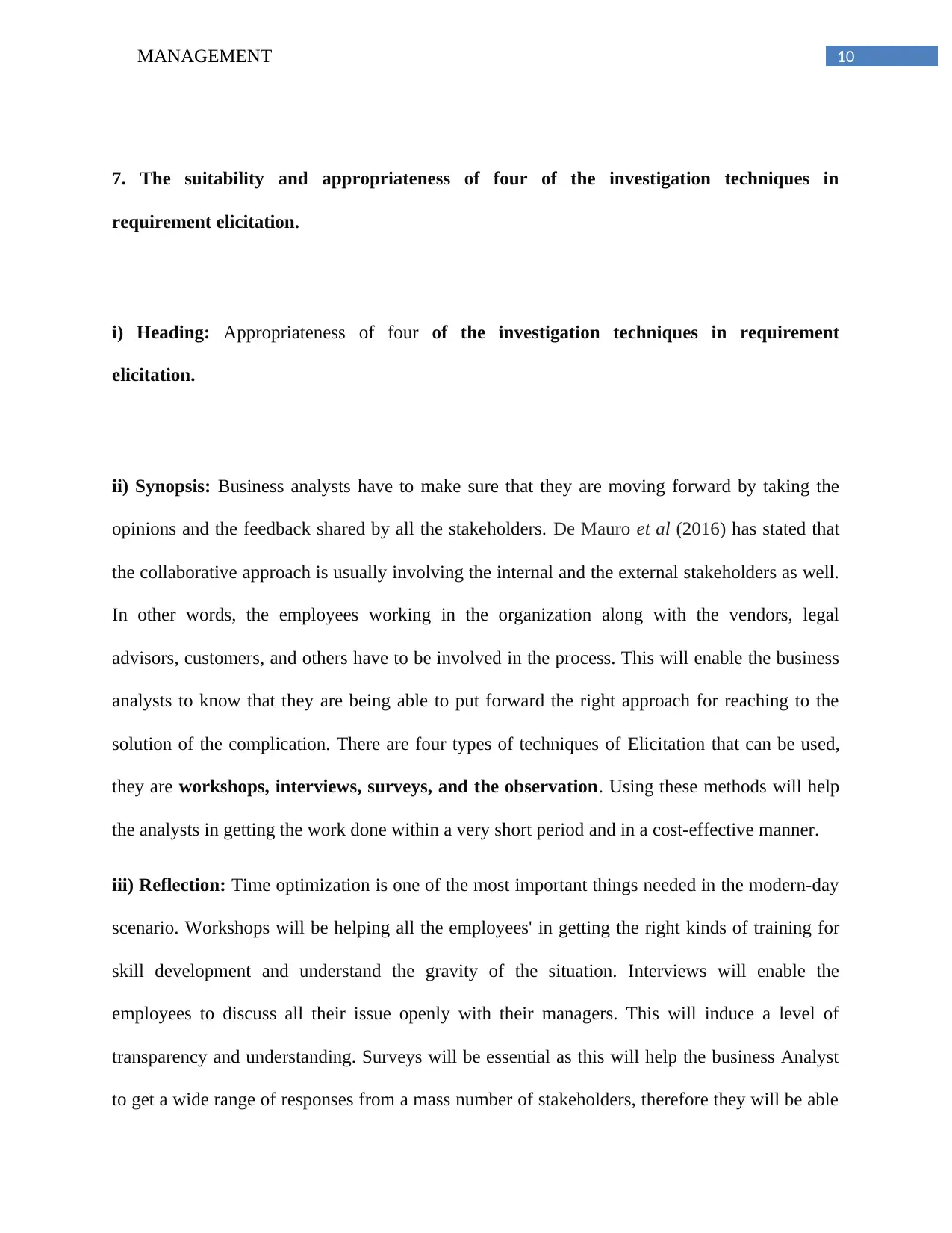
10MANAGEMENT
7. The suitability and appropriateness of four of the investigation techniques in
requirement elicitation.
i) Heading: Appropriateness of four of the investigation techniques in requirement
elicitation.
ii) Synopsis: Business analysts have to make sure that they are moving forward by taking the
opinions and the feedback shared by all the stakeholders. De Mauro et al (2016) has stated that
the collaborative approach is usually involving the internal and the external stakeholders as well.
In other words, the employees working in the organization along with the vendors, legal
advisors, customers, and others have to be involved in the process. This will enable the business
analysts to know that they are being able to put forward the right approach for reaching to the
solution of the complication. There are four types of techniques of Elicitation that can be used,
they are workshops, interviews, surveys, and the observation. Using these methods will help
the analysts in getting the work done within a very short period and in a cost-effective manner.
iii) Reflection: Time optimization is one of the most important things needed in the modern-day
scenario. Workshops will be helping all the employees' in getting the right kinds of training for
skill development and understand the gravity of the situation. Interviews will enable the
employees to discuss all their issue openly with their managers. This will induce a level of
transparency and understanding. Surveys will be essential as this will help the business Analyst
to get a wide range of responses from a mass number of stakeholders, therefore they will be able
7. The suitability and appropriateness of four of the investigation techniques in
requirement elicitation.
i) Heading: Appropriateness of four of the investigation techniques in requirement
elicitation.
ii) Synopsis: Business analysts have to make sure that they are moving forward by taking the
opinions and the feedback shared by all the stakeholders. De Mauro et al (2016) has stated that
the collaborative approach is usually involving the internal and the external stakeholders as well.
In other words, the employees working in the organization along with the vendors, legal
advisors, customers, and others have to be involved in the process. This will enable the business
analysts to know that they are being able to put forward the right approach for reaching to the
solution of the complication. There are four types of techniques of Elicitation that can be used,
they are workshops, interviews, surveys, and the observation. Using these methods will help
the analysts in getting the work done within a very short period and in a cost-effective manner.
iii) Reflection: Time optimization is one of the most important things needed in the modern-day
scenario. Workshops will be helping all the employees' in getting the right kinds of training for
skill development and understand the gravity of the situation. Interviews will enable the
employees to discuss all their issue openly with their managers. This will induce a level of
transparency and understanding. Surveys will be essential as this will help the business Analyst
to get a wide range of responses from a mass number of stakeholders, therefore they will be able
Paraphrase This Document
Need a fresh take? Get an instant paraphrase of this document with our AI Paraphraser
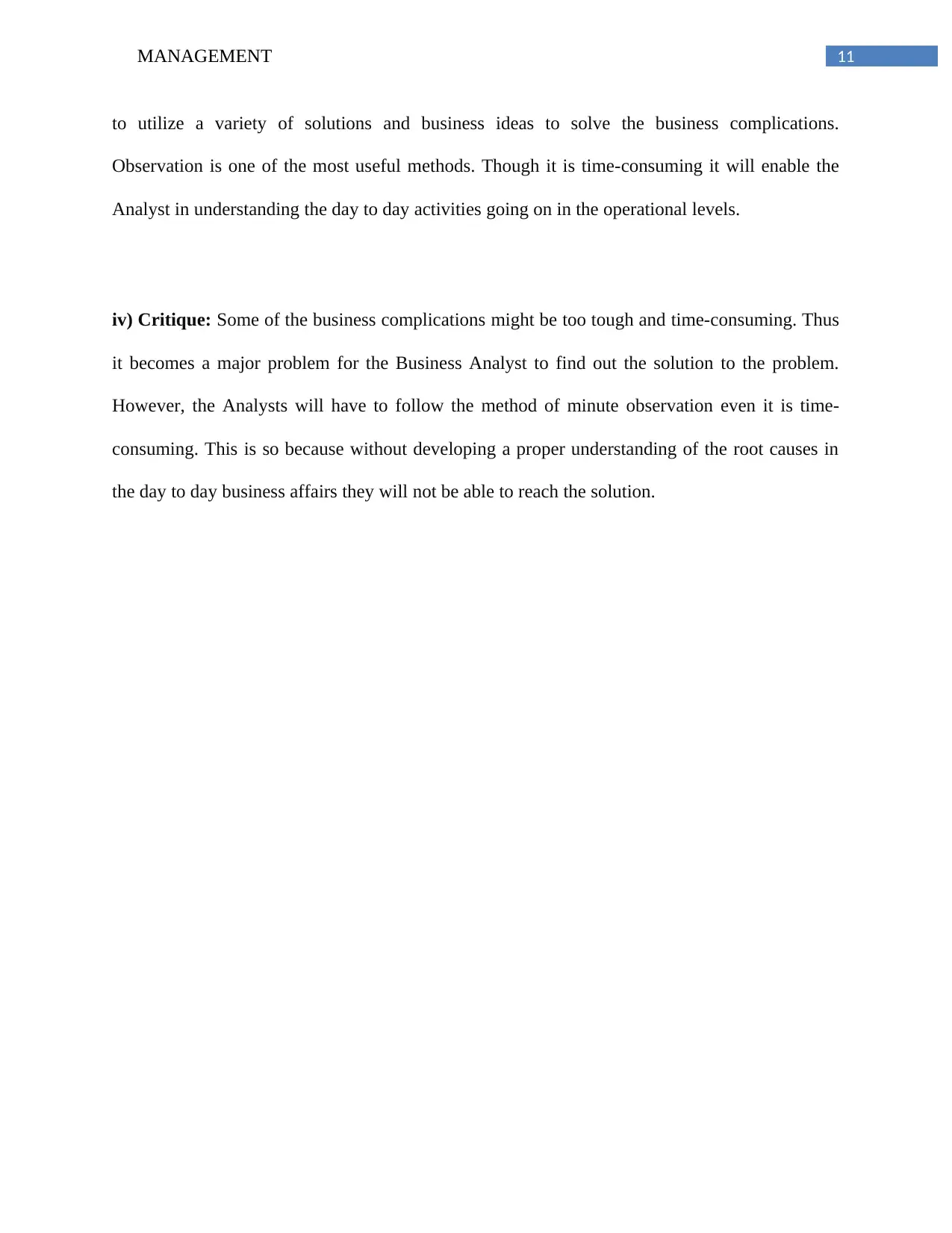
11MANAGEMENT
to utilize a variety of solutions and business ideas to solve the business complications.
Observation is one of the most useful methods. Though it is time-consuming it will enable the
Analyst in understanding the day to day activities going on in the operational levels.
iv) Critique: Some of the business complications might be too tough and time-consuming. Thus
it becomes a major problem for the Business Analyst to find out the solution to the problem.
However, the Analysts will have to follow the method of minute observation even it is time-
consuming. This is so because without developing a proper understanding of the root causes in
the day to day business affairs they will not be able to reach the solution.
to utilize a variety of solutions and business ideas to solve the business complications.
Observation is one of the most useful methods. Though it is time-consuming it will enable the
Analyst in understanding the day to day activities going on in the operational levels.
iv) Critique: Some of the business complications might be too tough and time-consuming. Thus
it becomes a major problem for the Business Analyst to find out the solution to the problem.
However, the Analysts will have to follow the method of minute observation even it is time-
consuming. This is so because without developing a proper understanding of the root causes in
the day to day business affairs they will not be able to reach the solution.
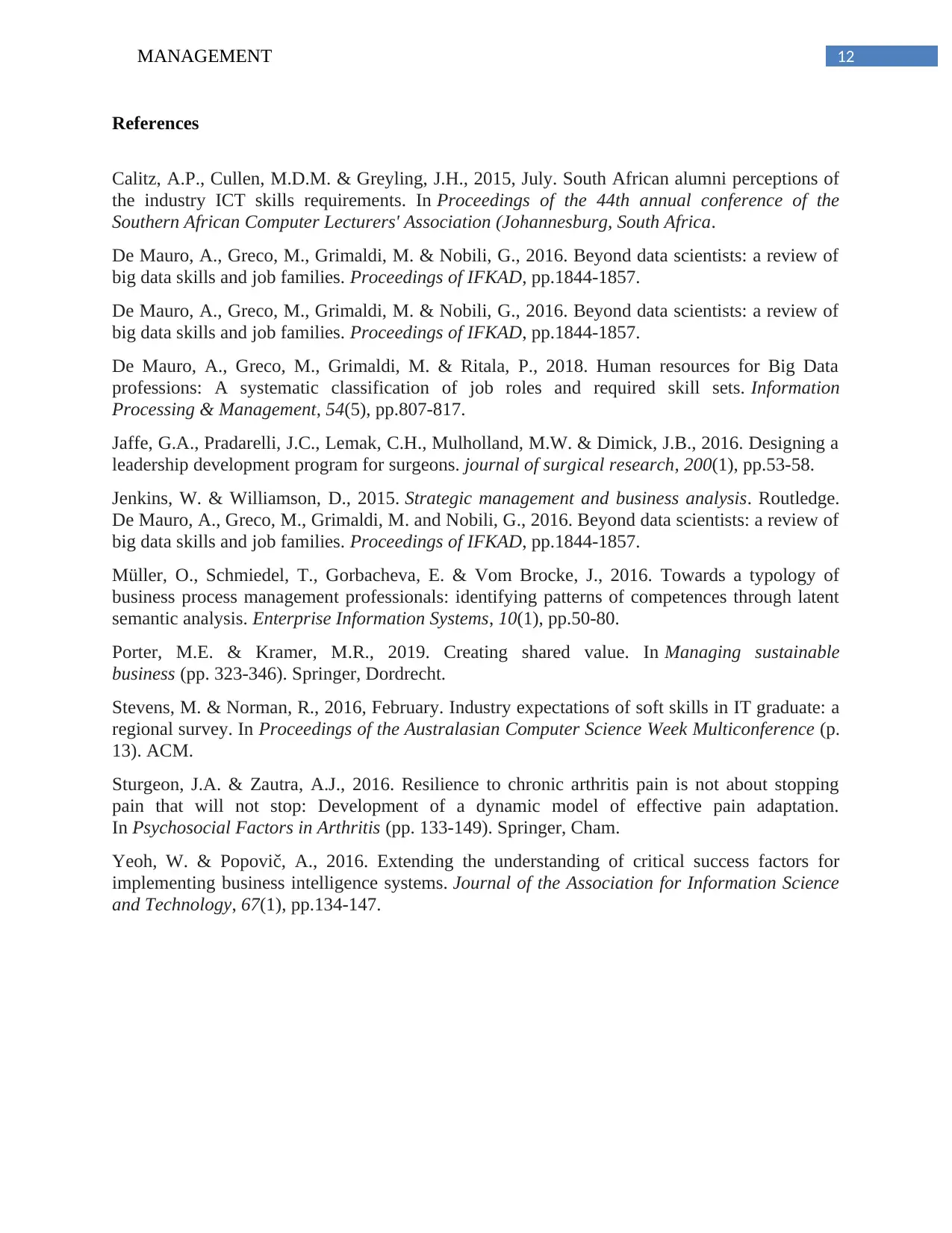
12MANAGEMENT
References
Calitz, A.P., Cullen, M.D.M. & Greyling, J.H., 2015, July. South African alumni perceptions of
the industry ICT skills requirements. In Proceedings of the 44th annual conference of the
Southern African Computer Lecturers' Association (Johannesburg, South Africa.
De Mauro, A., Greco, M., Grimaldi, M. & Nobili, G., 2016. Beyond data scientists: a review of
big data skills and job families. Proceedings of IFKAD, pp.1844-1857.
De Mauro, A., Greco, M., Grimaldi, M. & Nobili, G., 2016. Beyond data scientists: a review of
big data skills and job families. Proceedings of IFKAD, pp.1844-1857.
De Mauro, A., Greco, M., Grimaldi, M. & Ritala, P., 2018. Human resources for Big Data
professions: A systematic classification of job roles and required skill sets. Information
Processing & Management, 54(5), pp.807-817.
Jaffe, G.A., Pradarelli, J.C., Lemak, C.H., Mulholland, M.W. & Dimick, J.B., 2016. Designing a
leadership development program for surgeons. journal of surgical research, 200(1), pp.53-58.
Jenkins, W. & Williamson, D., 2015. Strategic management and business analysis. Routledge.
De Mauro, A., Greco, M., Grimaldi, M. and Nobili, G., 2016. Beyond data scientists: a review of
big data skills and job families. Proceedings of IFKAD, pp.1844-1857.
Müller, O., Schmiedel, T., Gorbacheva, E. & Vom Brocke, J., 2016. Towards a typology of
business process management professionals: identifying patterns of competences through latent
semantic analysis. Enterprise Information Systems, 10(1), pp.50-80.
Porter, M.E. & Kramer, M.R., 2019. Creating shared value. In Managing sustainable
business (pp. 323-346). Springer, Dordrecht.
Stevens, M. & Norman, R., 2016, February. Industry expectations of soft skills in IT graduate: a
regional survey. In Proceedings of the Australasian Computer Science Week Multiconference (p.
13). ACM.
Sturgeon, J.A. & Zautra, A.J., 2016. Resilience to chronic arthritis pain is not about stopping
pain that will not stop: Development of a dynamic model of effective pain adaptation.
In Psychosocial Factors in Arthritis (pp. 133-149). Springer, Cham.
Yeoh, W. & Popovič, A., 2016. Extending the understanding of critical success factors for
implementing business intelligence systems. Journal of the Association for Information Science
and Technology, 67(1), pp.134-147.
References
Calitz, A.P., Cullen, M.D.M. & Greyling, J.H., 2015, July. South African alumni perceptions of
the industry ICT skills requirements. In Proceedings of the 44th annual conference of the
Southern African Computer Lecturers' Association (Johannesburg, South Africa.
De Mauro, A., Greco, M., Grimaldi, M. & Nobili, G., 2016. Beyond data scientists: a review of
big data skills and job families. Proceedings of IFKAD, pp.1844-1857.
De Mauro, A., Greco, M., Grimaldi, M. & Nobili, G., 2016. Beyond data scientists: a review of
big data skills and job families. Proceedings of IFKAD, pp.1844-1857.
De Mauro, A., Greco, M., Grimaldi, M. & Ritala, P., 2018. Human resources for Big Data
professions: A systematic classification of job roles and required skill sets. Information
Processing & Management, 54(5), pp.807-817.
Jaffe, G.A., Pradarelli, J.C., Lemak, C.H., Mulholland, M.W. & Dimick, J.B., 2016. Designing a
leadership development program for surgeons. journal of surgical research, 200(1), pp.53-58.
Jenkins, W. & Williamson, D., 2015. Strategic management and business analysis. Routledge.
De Mauro, A., Greco, M., Grimaldi, M. and Nobili, G., 2016. Beyond data scientists: a review of
big data skills and job families. Proceedings of IFKAD, pp.1844-1857.
Müller, O., Schmiedel, T., Gorbacheva, E. & Vom Brocke, J., 2016. Towards a typology of
business process management professionals: identifying patterns of competences through latent
semantic analysis. Enterprise Information Systems, 10(1), pp.50-80.
Porter, M.E. & Kramer, M.R., 2019. Creating shared value. In Managing sustainable
business (pp. 323-346). Springer, Dordrecht.
Stevens, M. & Norman, R., 2016, February. Industry expectations of soft skills in IT graduate: a
regional survey. In Proceedings of the Australasian Computer Science Week Multiconference (p.
13). ACM.
Sturgeon, J.A. & Zautra, A.J., 2016. Resilience to chronic arthritis pain is not about stopping
pain that will not stop: Development of a dynamic model of effective pain adaptation.
In Psychosocial Factors in Arthritis (pp. 133-149). Springer, Cham.
Yeoh, W. & Popovič, A., 2016. Extending the understanding of critical success factors for
implementing business intelligence systems. Journal of the Association for Information Science
and Technology, 67(1), pp.134-147.
⊘ This is a preview!⊘
Do you want full access?
Subscribe today to unlock all pages.

Trusted by 1+ million students worldwide
1 out of 12
Related Documents
Your All-in-One AI-Powered Toolkit for Academic Success.
+13062052269
info@desklib.com
Available 24*7 on WhatsApp / Email
![[object Object]](/_next/static/media/star-bottom.7253800d.svg)
Unlock your academic potential
Copyright © 2020–2025 A2Z Services. All Rights Reserved. Developed and managed by ZUCOL.



